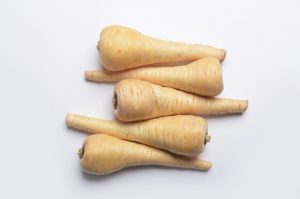♦ Parsnips are not just for roasting but they go a long way to creating a great flavour with other roast vegetables.

Parsnips are a classic favourite for roasting especially with a Sunday lunch. One reason why they are not as popularly grown as they should be is the need to sow the freshest seed possible. Germination rates rapidly decline as the seed ages so it’s simply not worth using that old packet in the cabinet.
The roots are cropped 32 to 36 weeks following sowing.
The parsnip is a common wild plant found in the British Isles and much of northern Europe. The plant is often found in the hedgerows and byways but its roots are certainly considerable smaller than the cultivars which have now been delivered. They belong to the old Umbellifer family but should not be readily picked by those sensitive to their sap. We know that the Pilgrim Fathers took parsnip seed with them on the Mayflower to the east United States.
Parsnips generally are a good source of vitamin C, potassium and folate although roasting tends to ruin the vitamins a to a certain extent but the flavour is what is required.
We all know they roast well and are excellent with roast meats, but they can also be boiled and mashed with butter. They also make a fine soup.
The best way to sow parsnips
In the greenhouse, place parsnip seeds on a damp paper as you would to generate sprouts and place inside a Ziplock pouch or bag. Don’t allow the seeds to touch the pouch. It’s a successful way to monitor germination and manage the seeds once they are germinated.
The best time to sow and grow is from February to May.
The seeds will sprout within 10 to 14 days on paper and need to be planted in good fertile soil outside before the young root becomes too long. Make sure the soil is well dug during the winter before sowing.
The alternative is to place a seed in a single deep-celled module usually about 1.5cm (1/2”) deep directly into compost. Old toilet roll tubes are just as good containers. Use a fine water rose to water the modules and any soil properly.
When sowing either direct outdoors or preparing the ground for the indoor grown seedlings, make sure the soil is rich with humus and compost. We do a manuring about 2 month beforehand and leave. The soil is then raked to a fine tilth.
If the seed is sown directly outside, then choose to do so between March and May about 1.25 – 1.5cm (1/2″ deep) in grooves drawn 30-38cm (12-15″) apart. Some varieties like ‘White Gem‘ can be sown as early as February.
The seedlings appear between 14 and 32 days.
Early sowings benefit from cloche protection.
Growing On
Thin once the seedlings are approximately 1″ high, leaving one plant per (20cm) 6″ apart. On average seedlings can be thinned to between 15-20cm (6-8”) apart. If you are short of space or want to grow smaller parsnips, sow closer together and thin to about 8cm. Ideally, allow 40cm (16”) between rows. Make sure the plants are watered.
Alternatively, selected parsnip varieties can be grown in containers which will produce mini roots.
Replace any dislodged soil as carefully as possible and water well until the plants are established. That is evident when they show clear signs of growth.
An evenly moist soil will help prevent splitting, so water if the weather is dry and apply a mulch to aid water retention.
Harvesting
Harvesting can begin in September, once the foliage begins to die down and often continues into the following spring. We prefer to leave any lifting until well into autumn.
Roots can be left in the ground in the winter and lifted as necessary. Autumn frosts improve the flavour but you may be wise to lift extra in November before the ground freezes. Lift the roots as required using a fork, being careful not to damage them. Harvest the roots from October onwards until February.
Parsnips can be stored in boxes of moist soil for up to a month, in a cool, dark place. Leave the roots in the ground until they are required.
Issues
Parsnip canker is one disease that can fell even a vegetable which is generally as robust as this is. The fungus Itersomilia pastinaceae can lay waste to a whole field of parsnips if it gets hold. It is first noticed as sunken, rotten-looking patches on the parsnip shoulders. These might look orange or in more serious cases, purple-black. The unaffected parts can still be eaten but it always leads to significant losses. To reduce the issue, rotate the crops by always growing parsnip on new ground so the disease doesn’t build up. Canker is worst in acidic soils so add lime to raise the pH above 6.5 to reduce acidity. Varieties said to be less prone to canker are ‘Avonresister‘, ‘Albion‘ and ‘Tender and True‘.
Varieties To Grow
Please note this page contains links to our affiliate marketing partner. Please read our affiliate disclosure.
Extra-Sweet Modern Types
Parsnip: cv. Albion F1 Excellent disease resistance. A smooth-skinned hybrid, producing first-class crops of long firm, tapering roots of excellent flavour and texture. Bred for resistance to the very latest strains of disease, including canker. Available from Dobies.
Parsnip: cv. Countess F1 (NIAB). A vigorous and disease-resistant hybrid, bearing hybrid crops of uniform, high quality white parsnips. Reliable in a variety of soils and seasons and has a very good taste and texture. Available from Dobies.
Parsnip: cv. Picador F1 Excellent canker resistance. A vigorous hybrid variety, producing an enviable crop of long, tapering, smooth-skinned roots, with excellent resistance to canker. Superb flavour.

Traditional, Large-Rooted Type
Parsnip: cv. Duchess. An early main crop variety with exceptionally white skins. It produces very vigorous healthy foliage and roots with a good shape. Boasting high resistance to canker it is an excellent variety for low-input growing. Can be harvested June to March, depending on sowing time.
Parsnip: cv. Exhibition (Dobies) The supplier claims it is one of the best varieties for exhibiting. Grows to an extremely large size. Good flavour and cooking quality.
Parsnip: cv: White Gem. One from King Seeds. A delicious, white and wedge-shaped variety. A brilliant choice for the beginner and has some canker resistance. Can be sown outdoors as early as February. Will survive frost happily and aging appears to improve its taste.
Gladiator F1.
Parsnip: cv. Hollow Crown. A variety grown in Britain from 1820. Maybe the oldest type of parsnip in cultivation. The name comes from the way the top of the parsnip drops in towards the leaves, forming a ‘crown’ shape. Each root grows to around 30cm (12″), with nice solid flesh and very sweet flavour. The roots need to be frosted before harvesting to bring out the best flavour and maximise the sweetness. Sow in February to May and harvest between October to December or January/February in the second year.
Parsnip: cv. Javelin. A flexible variety with the latest sowing time on the market. It has a last sowing date of the 3rd week in May. A proven variety with a good sweet flavour and excellent when roasted or even pureed.

Also try the heritage variety Student. This variety is very long rooted.
Purchase your parsnip seeds here

I found the tips really useful this year. I know that fresh seed is really important. Thanks for the advice.